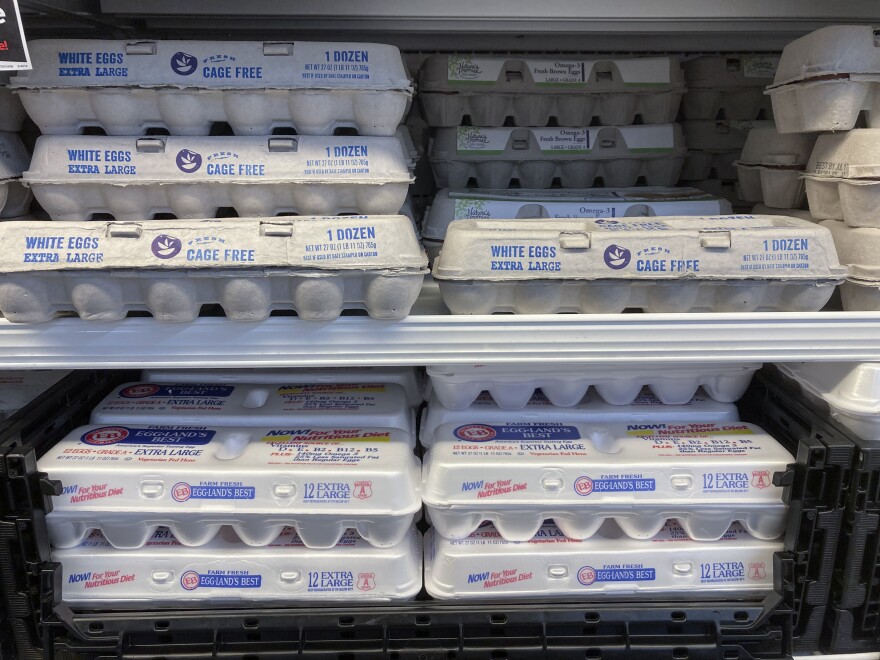The 40-year inflation high gripping the U.S. has affected the farming and food industries, pushing consumer costs for beef, pork, poultry, eggs and other food staples up by 10% or more.
A recent conversation with Todd Gleason, University of Illinois media communications specialist and host of WILL-AG 580’s Commodity Week and Closing Market Report programs, delved into some of the drivers behind higher food costs for consumers and whether or not farmers and ranchers are reaping the rewards.

“The U.S. government just released the consumer price index for this month, and it’s showing a year-over-year increase. This year compared to last year at this time, the price of food is up by around 10%. It’s not really that much of a surprise given what’s happening on the world stage in terms of energy and the availability of food, particularly with the war in Ukraine,” said Gleason, who has analyzed agricultural markets for the U of I since the 1980s.
“Combined, Russia and Ukraine are the No. 1 wheat exporters in the world, and they service a lot of the Black Sea area, a lot of African and the Middle Eastern nations. When it is not available from those nations, they have to turn to the United States for wheat,” he added.
The situation has resulted in demand exceeding supply for wheat, with predictable consequences. As of press time, July U.S. wheat was trading at between $10.70 and $12.21 per bushel, compared to less than $6 per bushel to begin 2021. With 22 million tons of Ukrainian grain estimated to be stuck in port silos since shipments were halted on February 24, some Illinois farmers may be considering planting more wheat this fall for harvest in spring 2023.
Wheat is not the only agricultural commodity that is seeing a major boost in prices. Harvest-time bids for 2023 corn is at $5.60 per bushel and $13.10 for soybeans, U of I economists project, which is above average historical harvest time bid levels.
However, farmers are now paying more than 50 percent higher prices for diesel fuel, fertilizers and other farm “inputs” required to grow a crop and raise animals. Costs were estimated at $1,515 per ton for anhydrous ammonia, $892 per ton for urea, $862 for Diammonium Phosphate (DAP), and 818 for potash in March, when many Illinois farmers were completing their spring fertilizer applications. The increase in fertilizer prices indicate that the sanctions resulting from the Ukraine-Russia conflict will be long-lasting and result in higher prices, according to the U of I farmdoc team.
Prices vs. profits
So do the high commodity prices mean that U.S. farmers are experiencing windfall profits?
“The answer is both yes and no, and part of the answer is relatively simple,” said Gleason. “For instance, the price of grain started to go up last fall when the price of energy started to rise. But farmers already had grain in the bin that they’d harvested the past year. The price of corn was only around $4 per bushel, compared to the $6.50 per bushel average it’s estimated at for this marketing year.
“So this past year, farmers made a lot of money, because the price for grain was really high but their inputs were not. This year, they won’t make nearly as much money because the price for inputs is higher. Though they are being paid more for grain, they simply won’t make as much money.”
In 2020, much of the U.S. farmer’s income was derived from COVID and other ad hoc emergency payments authorized by Congress. Their average income was estimated at around $133 per acre for corn. In 2021, with lower input prices paid for growing their 2020-21 crops, farmers realized an income of $500 per corn acre. This year, the estimated per-acre income for farmers will dip to $365 per corn acre.
“But, they are going to spend a lot of that on next year’s input prices, and they probably will plant more grain and oilseeds not only here, but across the planet. I would expect the 2023 price for grain and oilseeds will be much lower. So the answer is yes, they are making more money, but no, they probably will not make more money over time,” Gleason said.
According to the National Farmers Union, the farmer’s share of the U.S. food dollar in 2019 was just 14.3 cents. Off-farm costs including marketing, processing, wholesaling, distribution and retailing account for more than 80 cents of every food dollar spent in the United States, USDA data reveals.
For instance, a one-pound package of bacon that costs $6.49 returns $1.07 to a farmer, while a one-pound top sirloin steak that fetches $10.49 at the supermarket puts $1.98 back into a farmer’s pocket. A loaf of bread that sells for $3.99 brings a wheat producer just 19 cents, while milk, at $3.79 per gallon, pays $1.55 to a dairy producer. A six-pack of beer that sells for $9.99 returns just five cents to a wheat or barley farmer, according to the NFU.
“Even though family farmers and ranchers are more productive today than they have ever been, they’re taking home a smaller and smaller portion of the American food dollar,” said Roger Johnson, NFU president, in 2019.


